If I Preserve Peppers in Oil Will They Continue to Change Color
This post may contain affiliate links, view our disclosure policy for details.
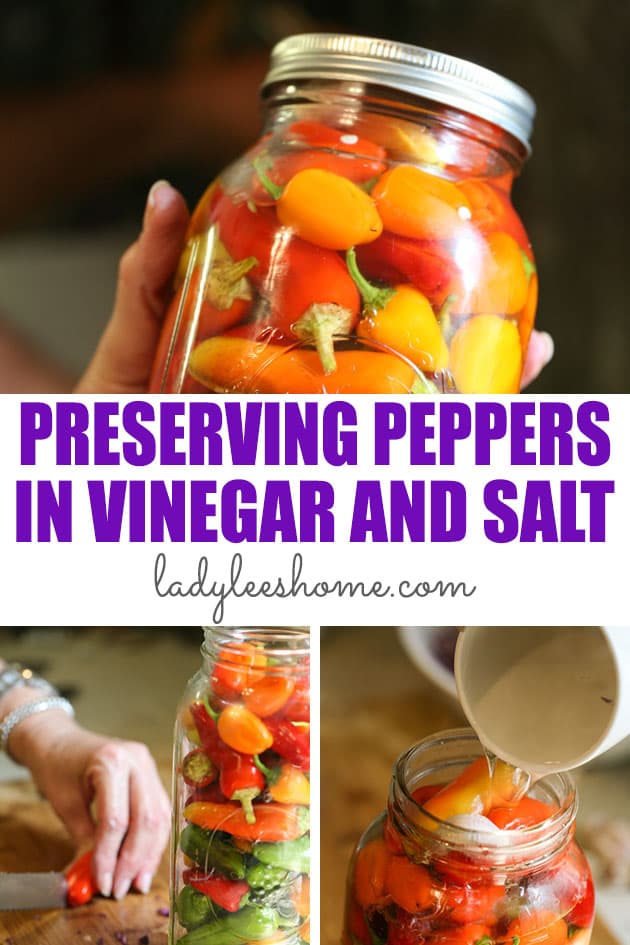
Jump to Recipe
Preserving peppers in vinegar and salt is super easy. It takes minutes to put this dish together and it's a great way to preserve peppers. It takes a few days to ferment and once it's ready it's a healthy and tasty snack or an addition to salads or sandwiches.
One of my favorite varieties of peppers to grow in the summer garden is Lunchbox peppers. They are relatively easy to grow and each plant produces a ton of peppers.
We eat most of them as a snack right in the garden, but since each plant produces so many peppers I'm often left with a lot of peppers that I have to somehow preserve.
Preserving Peppers in Vinegar and Salt…

I do love canning and appreciate the fact that I can store canned goods on a shelf at room temperature, but sometimes I just don't have time for all the boiling and hot processing. Sometimes, I just need a quick way for preserving that involves no cooking at all.
A couple of years ago, my mother came from Israel for a visit during the growing season and showed me a simple way to preserve peppers in vinegar and salt. It takes only a few minutes to put a jar together, no cooking whatsoever, and the result is delicious. Perfect.
Ingredients…
- Peppers – this recipe is very simple and is such an easy way to preserve the little lunchbox peppers. However, if you don't have lunchbox peppers that's totally fine! You can follow this recipe to preserve any kind of pepper, sweet or hot, in vinegar and salt. If you use small or skinny peppers, you can pack them in the jar whole, if you use larger peppers, you are probably going to have to cut them and remove the seeds before packing them in the jar.
Also, you can use this same way to preserve other vegetables too like cabbage, cauliflower, kohlrabi, fennel, carrots, beets, and radish. If you'd like, you can mix a few different vegetables in the jar. - Seasonings – to season your peppers you can use just garlic (as we did below) or you can add dill, thyme, mustard seeds, pickling spice mix, peppercorns, chili flakes, or anything else that you can come up with. Try something different each time until you find your favorite seasoning combination.
- Vinegar – we are going to add some vinegar, I used 5% white vinegar and I actually never tried this recipe with any other kind of vinegar but I believe that as long as your vinegar is at least 5% acidic it should be just fine.
- For the brine – then, for the brine, we are going to need salt and boiling water. When you use salt to preserve food, always make sure that you use kosher, sea, or canning salt and not table salt. Also, it's better to use non-chlorinated water.
Kitchen Tools…
- Cutting board
- knife
- Jar with a wide mouth – we used half a gallon but you can also use a gallon or a quart.
- Measuring cup
- Measuring spoon.
- Fermentation weight
- Lid – I used a regular lid here but I actually recommend using a freezer lid to close the jar since it won't rust like the metal one. You can also try using fermentation lids that let the gases out and prevent you from needing to burp the jar (more on this later).
How to Preserve Peppers in Vinegar and Salt…
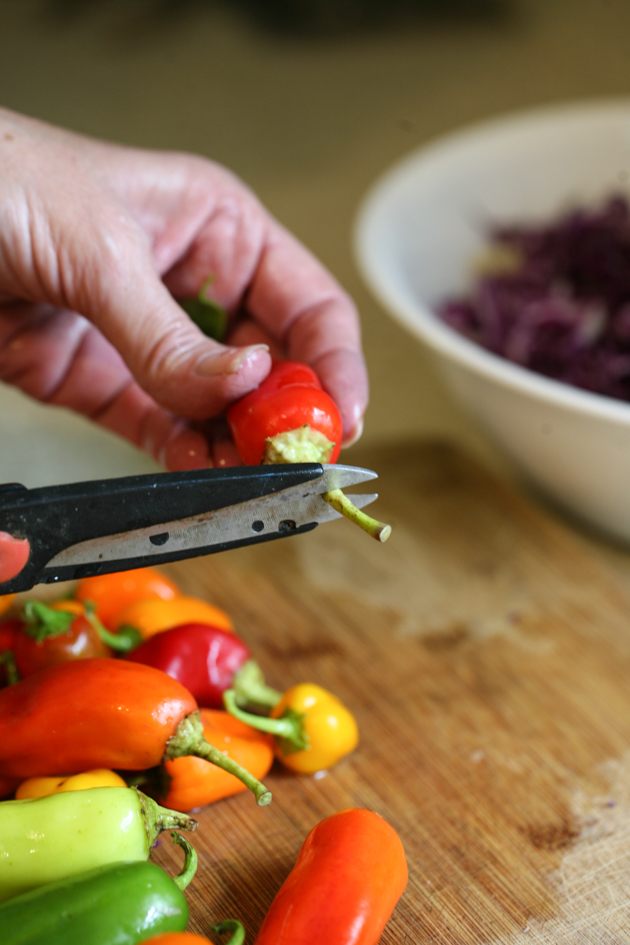
Step 1 – pack the jar. Start by washing the peppers and getting rid of the stem…
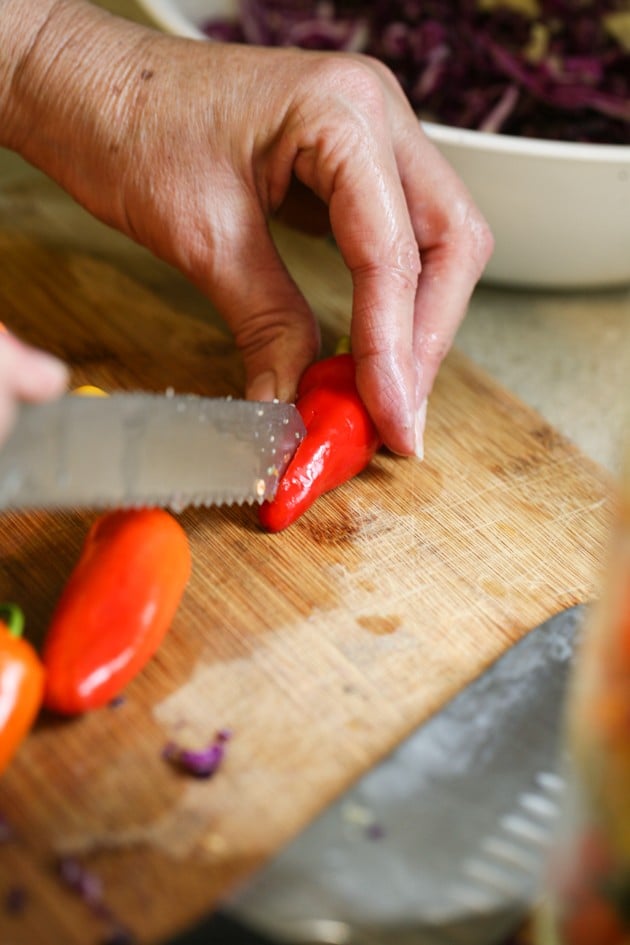
Next, make a little slit in the bottom half of the pepper. If you are doing this with bell peppers, you'll cut them into large pieces and remove the seeds. The little lunchbox peppers have hardly any seeds in them, so we used them whole but made a little cut so the vinegar and salt can get inside.
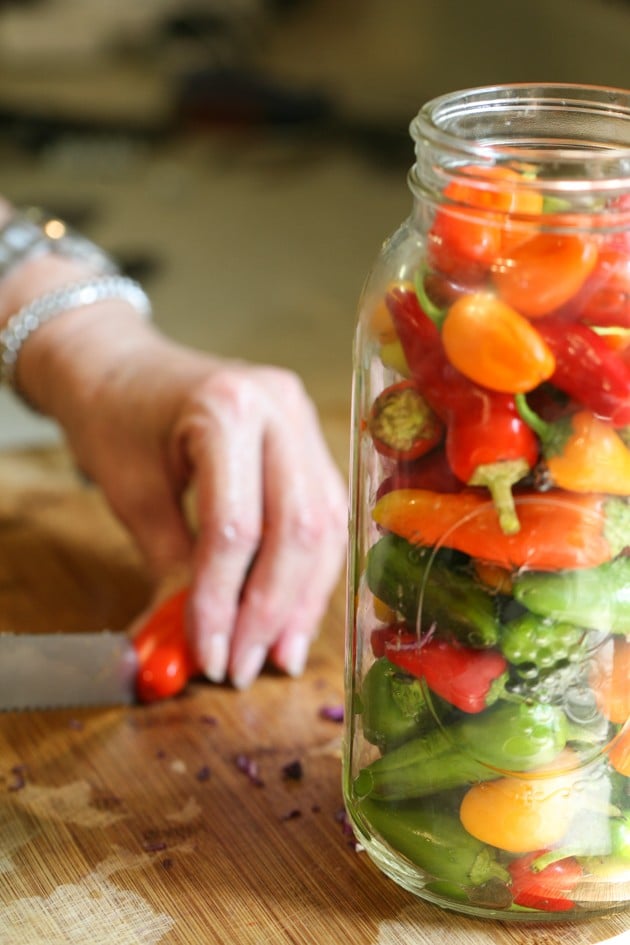
Keep going until the jar is full. Make sure to leave about 2" of headspace.
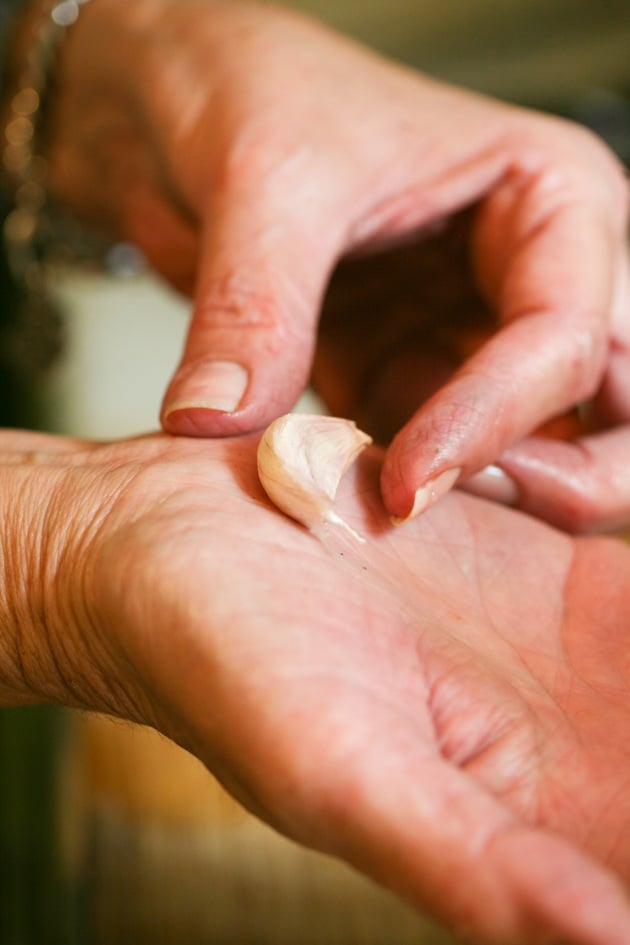
Step 2 – add seasonings. Take one garlic clove and crush it (no need to peel it), then add it to the jar. If you choose to use any other seasonings, add them as well.

Step 3 – add the brine. Once the jar is packed with the peppers and the seasonings, it's time to add the brine. First, add between 1/2 – 1 cup of vinegar to a half-gallon jar. If you use a quart, add between 1/4 -1/2 a cup of vinegar. How much you add only depends on how much you like vinegar. If you like the taste add more, if you don't love the taste of vinegar, add less.
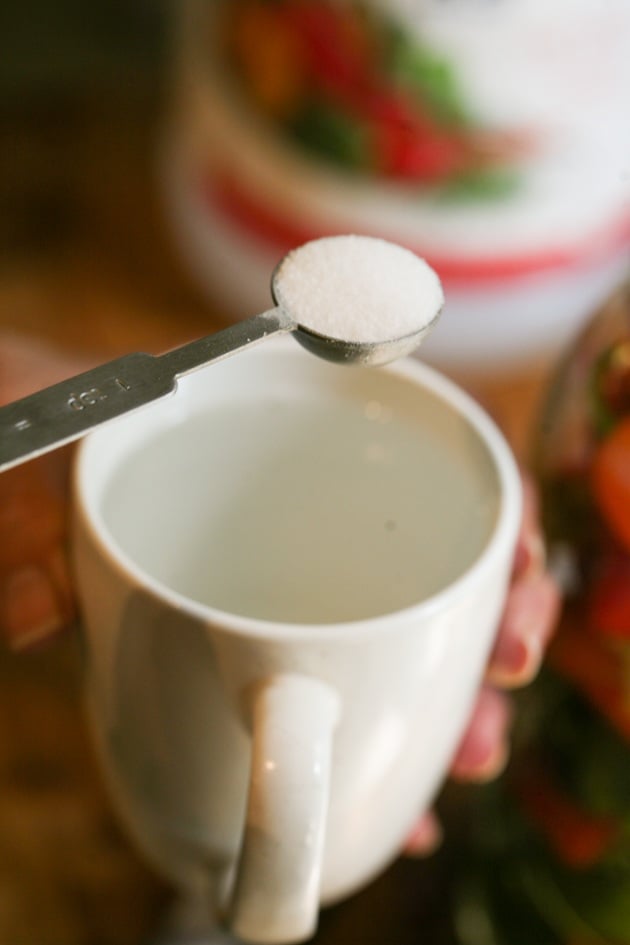
Next, boil some water. To every cup of boiling water, add one teaspoon of salt…
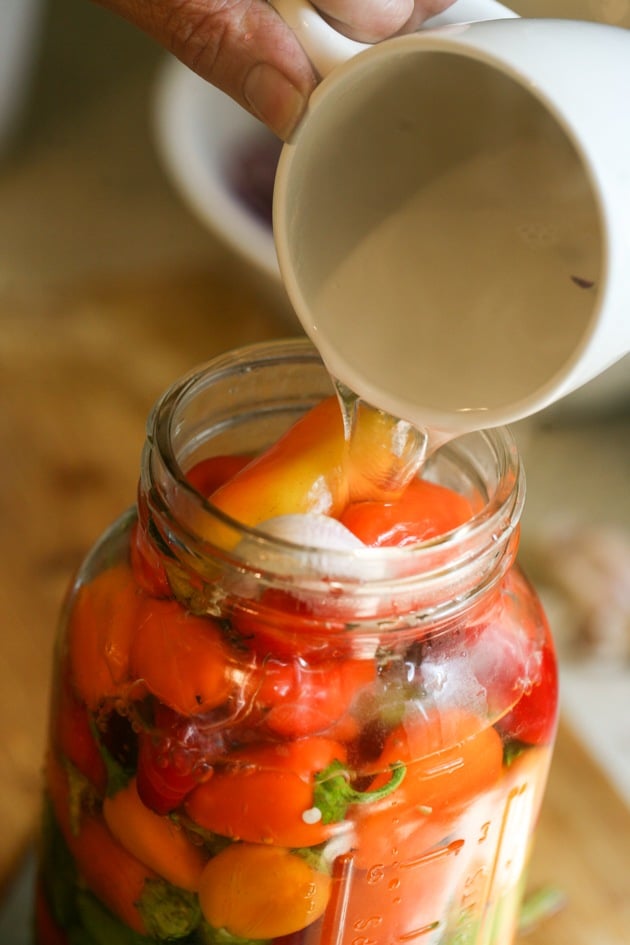
Mix to dissolve the salt and add to the jar. Keep filling your cup with boiling water, add salt, mix, and add to the jar until the peppers are covered with the brine.
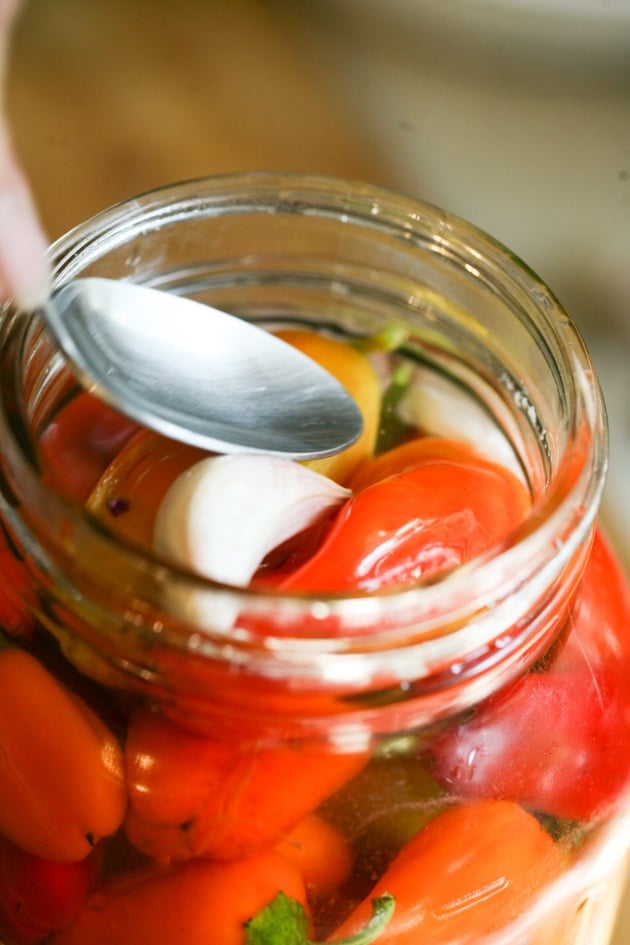
Step 4 – add fermentation weight and close the jar. You want to make sure that you keep all the peppers under the brine. The best way to do that is to use a fermentation weight. Place the weight on top of the peppers and push down a bit to make sure that all the peppers are submerged in the bring. Then, close the jar with a clean lid.
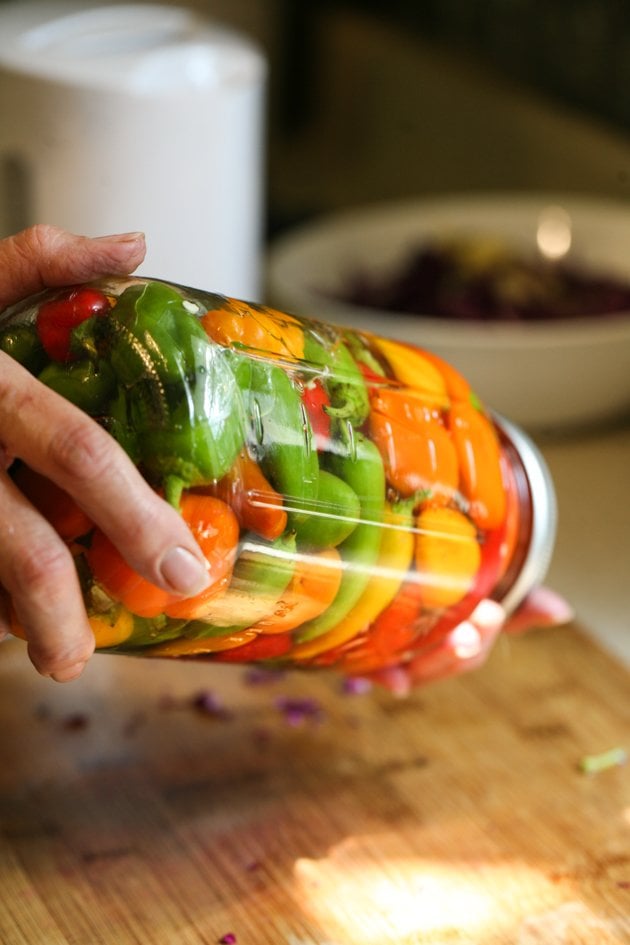
Gently turn the jar a few times to mix the vinegar that we added at the beginning with the rest of the salty brine.
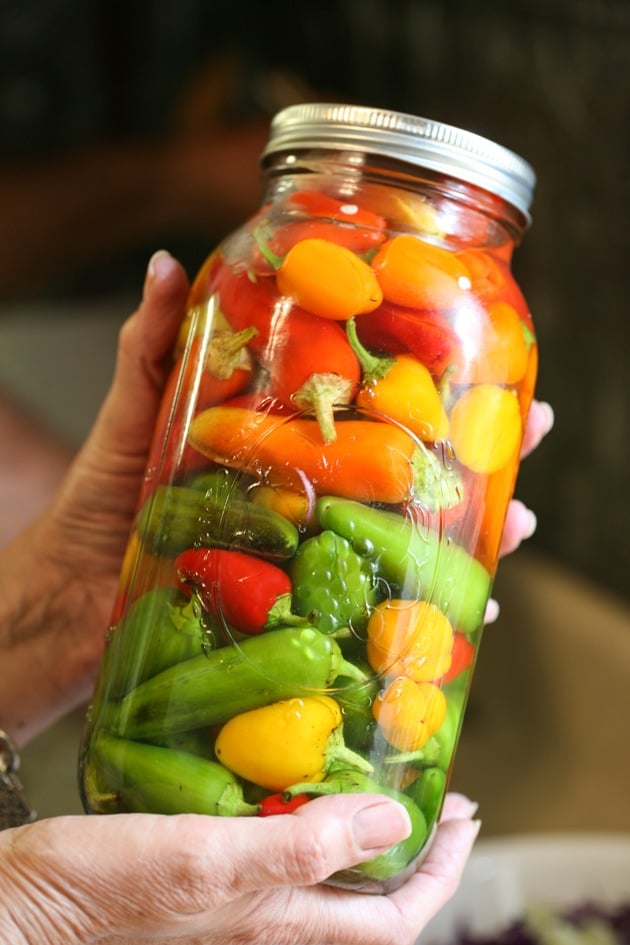
Step 7 – let ferment. Since we added vinegar, we should call these peppers pickled peppers, however, they behave much like fermented peppers because there is a salty brine in there as well. So set the jar of peppers on the kitchen counter at room temperature to pickle/ferment for about a week…
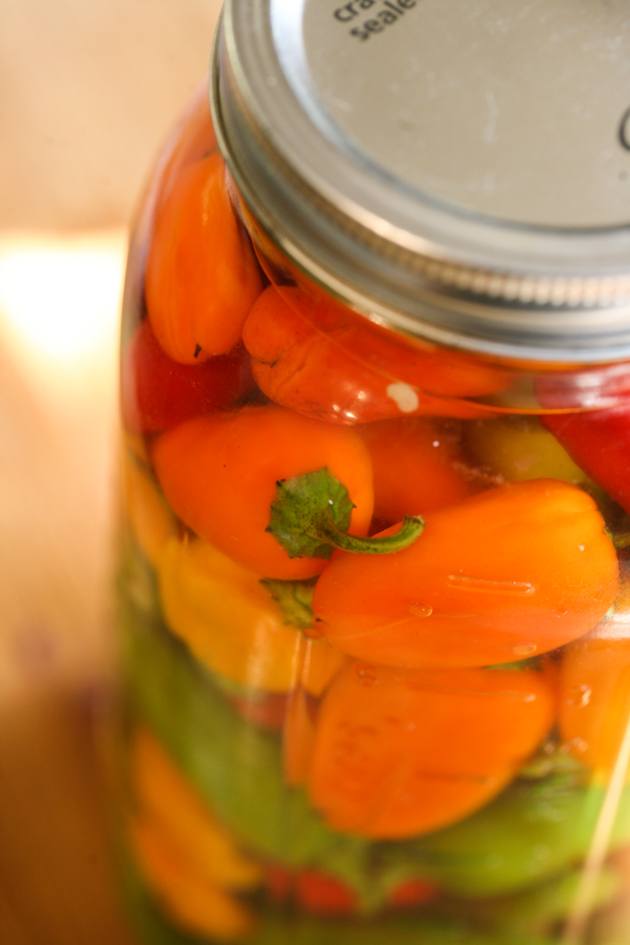
You'll notice that after a few days the peppers start to change their color and the brine starts to get foggy, that's normal and part of the process. You'll also notice some bubble action. You'll see some bubbles starting to rise to the top and maybe some foam forming on the top.
Don't remove it, but you do need to make sure to burp the jar, or in other words, let some of the gases that form inside the jar escape. To do that, once a day, simply twist the lid open, don't lift it, just twist it open for a couple of seconds and then close it again.
Storing Preserved Peppers…
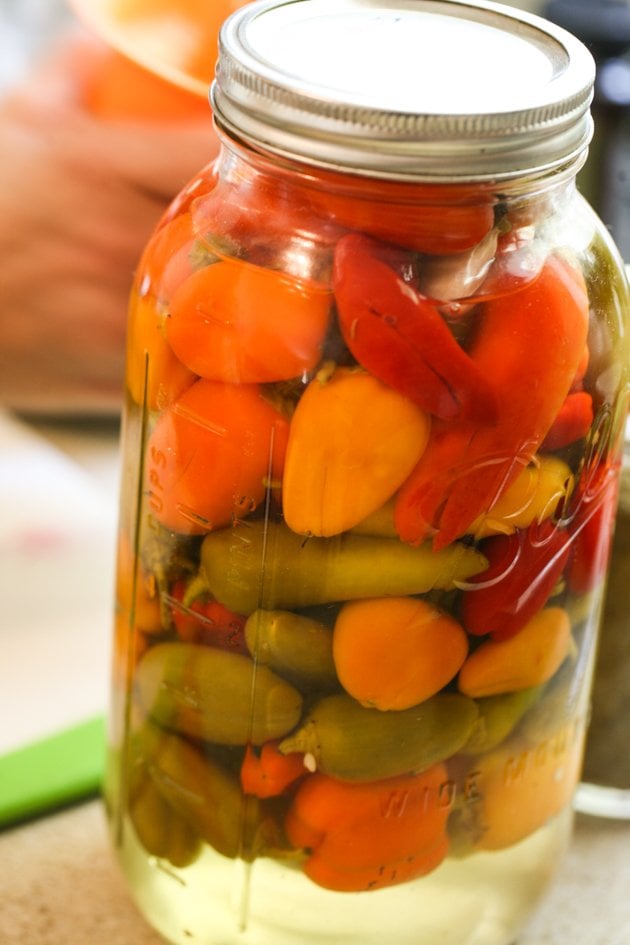
After a week to two weeks (depending on the size of jar that you are using), you'll notice that the brine turns clear again. It will never be as clear as it was when we first added it but the fogginess will disappear. This means that your peppers are ready to be served and stored.
You want to store your jar in cold storage. If you have a root cellar, that's best. If not, the fridge will do fine. The jar can stay in room temperature for a few weeks, however, I find that the peppers soften and lose their crunchiness much faster than if stored in cold storage.
Serving Peppers in Vinegar and Salt…
These peppers are a very healthy snack! Just grab a couple to munch on when you feel the urge for a little snack. I often serve them as a side to a sandwich too. They are a great side for a pulled meat wrap, a bbq sandwich, or a hamburger. They are also a great addition to Southwest chicken chili or a shakshuka dish.
I also often add them to salads. I add them to a Mediterranean egg salad, a tuna salad, or a chicken salad. And I was thinking that they might be a great addition to casseroles too, like this Mediterranean zucchini casserole.
This is such a simple recipe that I think that every homesteader should have on hand, not just for preserving peppers, but for other vegetables as well. I hope that you'll give it a try!
More Pepper Content on the Blog…
- Canning Hot Peppers
- Can Roasted Red Peppers
- Candied Jalapenos.
- How to Make Red Pepper Paste
- Mediterranean Stuffed Peppers
- How to Roast Poblan Peppers (and how to can them)
More Fermenting Recipes…
- Ferment Jalapenos
- Ferment Beets
- Ferment Radish
- Ferment Turnips
- Fermenting Cucumbers
- Ferment Tomatoes
- Ferment Green Beans
Ingredients
- Enough Lunchbox peppers to fill a 1/2 gallon jar
- 1 garlic clove, crushed (no need to peel it)
- 1 cup vinegar
- Kosher, canning, or sea salt
Instructions
- Wash your peppers and remove the stem (not the top of the pepper, just some of the stem).
- Make a slit at the bottom of each pepper.
- Pack a 1/2 gallon jar with the peppers, leaving 2 inches of headspace.
- Add the garlic clove on top of the peppers and add additional seasonings if you like (see notes below).
- Add 1 cup of vinegar to the jar (you can add anywhere between 1/2 cup to 1 cup depending on how much you like the taste of vinegar).
- Boil water. Fill a cup with boiling water, add a teaspoon of salt, mix until the salt dissolves and add the solution to the jar. Keep adding cups of water and salt until the jar is full and the peppers are covered.
- Place a fermentation weight on top of the peppers and close the jar. Turn it a couple of times to get the vinegar mixed with the brine.
- Place it at room temperature to ferment for 5 to 7 days. Make sure to burp the jar every day by unscrewing the lid and screwing it back on. The peppers will change their color and the liquid will become foggy and then clear again. The peppers are ready once the liquid clears.
- You can enjoy the peppers right away or you can store the jar in a cool place (like a root cellar or a fridge) for a few months.
Notes
You can follow this recipe to preserve any kind of pepper, sweet or hot, in vinegar and salt. If you use small or skinny peppers, you can pack them in the jar whole, if you use larger peppers, you are probably going to have to cut them and remove the seeds before packing them in the jar.
Also, you can use this same way to preserve other vegetables too like cabbage, cauliflower, kohlrabi, fennel, carrots, beets, and radish. If you'd like, you can mix a few different vegetables in the jar.
To season your peppers you can use just garlic or you can add dill, thyme, mustard seeds, pickling spice mix, peppercorns, chili flakes, or anything else that you can come up with. Try something different each time until you find your favorite seasoning combination.
Nutrition Information:
Yield: 20 Serving Size: 1
Amount Per Serving: Calories: 20 Total Fat: 0g Saturated Fat: 0g Trans Fat: 0g Unsaturated Fat: 0g Cholesterol: 0mg Sodium: 31mg Carbohydrates: 0g Fiber: 0g Sugar: 0g Protein: 0g

Hi! I'm Lady Lee. I help homesteaders simplify their homesteading journey while still producing a ton of food! I am a single mother of four, I was born in Israel and raised in an agricultural commune called a Kibbutz. Now I homestead in central NC.
Source: https://ladyleeshome.com/preserving-peppers-vinegar-salt/
0 Response to "If I Preserve Peppers in Oil Will They Continue to Change Color"
Post a Comment